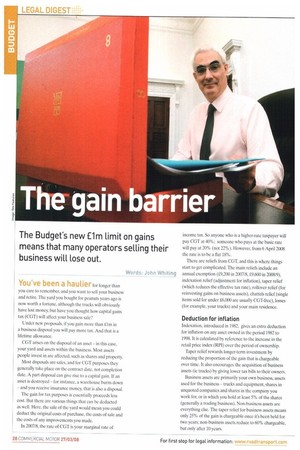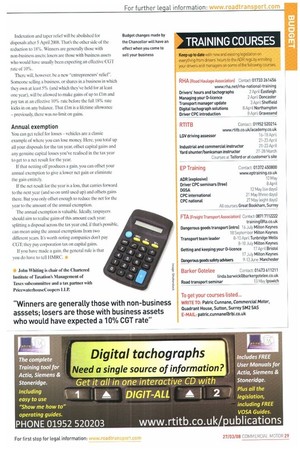The gain barrier
Page 28

Page 29

If you've noticed an error in this article please click here to report it so we can fix it.
The Budget's new Elm limit on gains means that many operators selling their business will lose out.
Words: John Whiting
You've been a haulier for longer than you care to remember, and you want to sell your business and retire. The yard you bought for peanuts years ago is now worth a fortune, although the trucks will obviously have lost money, but have you thought how capital gains tax (CGT) will affect your business sale?
Under new proposals, if you gain more than Ulm in a business disposal you will pay more tax. And that is a lifetime allowance.
COT arises on the disposal of an asset in this case, your yard and assets within the business. Most assets people invest in are affected, such as shares and property.
Most disposals are sales, and for CGT purposes they generally take place on the contract date, not completion date. A part disposal can give rise to a capital gain. If an asset is destroyed for instance, a warehouse burns down and you receive insurance money, that is also a disposal.
The gain for tax purposes is essentially proceeds less cost. But there are various things that can be deducted as well. Here, the sale of the yard would mean you could deduct the original costs of purchase, the costs of sale and the costs of any improvements you made.
In 2007/8, the rate of CGT is your marginal rate of income tax. So anyone who is a higher-rate taxpayer will pay CGT at 40%; someone who pays at the basic rate will pay at 20% (not 22%). However, from 6 April 2008 the rate is to be a flat 18%.
There are reliefs from CGT, and this is where things start to get complicated. The main reliefs include an annual exemption (£9,200 in 2007/8, £9,600 in 2008/9), indexation relief (adjustment for inflation), taper relief (which reduces the effective tax rate), rollover relief (for reinvesting gains on business assets), chattels relief (single items sold for under £6,000 are usually CGT-free), losses (for example, your trucks) and your main residence.
Deduction for inflation
Indexation, introduced in 1982. gives an extra deduction for inflation on any asset owned in the period 1982 to 1998. It is calculated by reference to the increase in the retail price index (RPI) over the period of ownership.
Taper relief rewards longer-term investment by reducing the proportion of the gain that is chargeable over time. It also encourages the acquisition of business assets (ie trucks) by giving lower tax bills to their owners.
Business assets are primarily your own business, assets used for the business trucks and equipment, shares in unquoted companies and shares in the company you work for, or in which you hold at least 5% of the shares (generally a trading business). Non-business assets are everything else. The taper relief for business assets means only 25% of the gain is chargeable once its been held for two years; non-business assets reduce to 60% chargeable, but only after 10 years. Indexation and taper relief will be abolished for Budget changes made by disposals after 5 April 2008. That's the other side of the the Chancellor will have an reduction to 18%. Winners are generally those with effect when you come to non-business assets; losers are those with business assets sell your business who would have usually been expecting an effective CGT rate of 10%.
There will, however, he a new "entrepreneurs' relief-. Someone selling a business, or shares in a business in which they own at least 5% (and which they've held for at least one year), will be allowed to make gains of up to Lim and pay tax at an effective 10% rate before the full 18% rate kicks in on any balance. That flm is a lifetime allowance — previously, there was no limit on gains.
Annual exemption
You can get relief for losses — vehicles are a classic example of where you can lose money. Here, you total up all your disposals for the tax year, offset capital gains and any genuine capital losses you've realised in the tax year to get to a net result for the year.
If that netting off produces a gain, you can offset your annual exemption to give a. lower net gain or eliminate the gain entirely.
If the net result for the year is a loss, that carries forward to the next year (and so on until used up) and offsets gains there. But you only offset enough to reduce the net for the year to the amount of the annual exemption.
The annual exemption is valuable. Ideally, taxpayers should aim to realise gains of this amount each year: splitting a disposal across the tax year end, if that's possible, can mean using the annual exemptions from two different years. It's worth noting companies don't pay CGT; they pay corporation tax on capital gains.
If you have made a gain, the general rule is that you do have to tell IIMRC. a




























































































































































